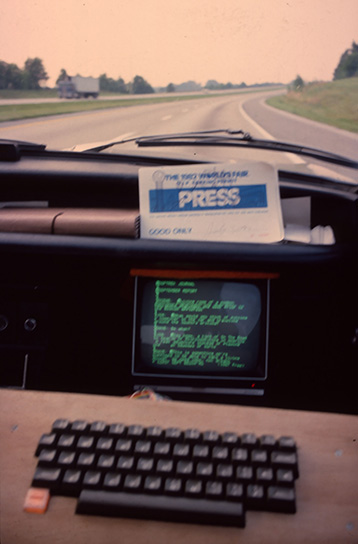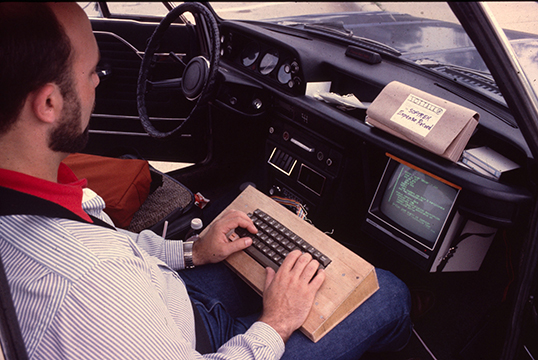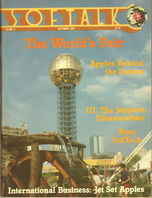When I surfaced the boxes of Softalk magazines that now form the core of The Softalk Apple Project source material, one box contained some extra goodies. The most unusual item was a still-unseparated printout of the prologue to a cover story I'd written literally 'on the road' for Softalk. Not Kerouac-style on the road; my model was 1970's icon Charles Kuralt and his 'On the Road... with Charles Kuralt' stories on the CBS Sunday Morning television show. In Part 2 of this 'More to the Story' story, you'll learn just how hard it was to 'go mobile' in 1982. (Here's Part 2 if you want to know more about Softrek... before reading the rest of Part 1.)
--Jim--

The first part of our Softrek trip took us up through New England and upstate New York, down through Pennsylvania. After a restocking and a mobile office set-up tweak in Baltimore we headed out on the 'Smile Route' into the Southern states. Our primary objective was to cover the behind-the-scenes story of how Apple computers were being used at the 1982 Knoxville World's Fair.
After the Fair, we had an interview scheduled in a remote Kentucky state park with an executive of a Louisville bank that was creatively using a network of Apples in their branch offices. We started this post-Fair leg of the trip on familiar highways like you see in the writer's POV (point of view) photo on this page. After the meeting-interview in the state park, we made a bee-line from Kentucky back to Baltimore before our next leg of the Softrek adventure. What Bear and I experienced when we left 'the road' part of 'on the road' and went 'off the beaten track' is what I wrote about below.
Here (in 'simulated' dot-matrix printout style) is the unpublished prologue to the cover story "The World's Fair - Apples Behind the Scenes" (Vol. 3 No. 1. I've scanned this issue but it is not on-line yet. I will link to the published article soon.)
Had we taken a different route and means of transportation, the impact of having visited the Knoxville World's Fair would not have been so dramatic. Returning to Baltimore by way of the tiniest backroads through rural Eastern Kentucky and West Virginia, we were vividly reminded that the basis of the differentiation between the Haves and Have-Nots finds its clearest expression in Technology. There are no Apple computer retail stores in the towns along these roads. There is no need.
Technology is expressed in the tools developed as a means to the solution of the major problems which face the tool user. The folks in the remote reaches of Appalachia are struggling against the same problems which faced their parents, grandparents, and great-grandparents; simple survival. Removed from the economic vitality of urban development, the opportunity for change is diminished.
Jobs are few and far between. Those few available are low-paying. Without surplus income there is no money for productivity-increasing tools. It takes all available time and energy to meet the demands of basic subsistence. These folks don't need microcomputers to catch up. They need electricity, running water, and sewage. They are trapped in a Technology Black Hole. The Energy Crisis is a matter of cutting enough wood for the coming winter.
As we drove through this technology-poor area, word processor cranked up on our in-car computer, I couldn't help feeling our vehicle was an exploratory probe dropped from a starship to investigate conditions on a newly discovered planet. We were strangers in a strange land. Science-fiction metaphors were appropriate to the moment.
The Knoxville World's Fair might just as well have been on a planet orbiting a star in the constellation of Orion, this destination being but a few time units away at warp speed. Yet we had arrived by way of fossil-fuel-burning internal combustion at speeds that rarely topped 50 miles an hour.
Having made this journey from Technology Wonderland to the barren Tool Desert, I cannot turn on my Apple computer without thinking how lucky I am to own such a fantastically powerful device. Our childhood frustrations of having been born too soon before science-fiction becomes reality are dissolved by the realization that we are living in a world unimagined to even the most forward thinking of just a generation before us.
Those of us with access to these state-of-the-art tools are given the opportunity to solve the problems that keep us from rising above the demands of simple survival. The challenge is to make these inevitable advancements without deepening the division between us Haves and the Have-Nots.
Such a challenge must be addressed by a marriage of scientific development and a sense of humanity, of concern for our collective welfare. And this is the context of this year's and the previous World's Fairs; celebrations of the human Can-Do attitude that has brought us from leaf-nibbling foragers to Tang-sucking spacewalkers in the blink of a Cosmic Eye.
From the moment that our cognitive abilities shifted the impact of environmental adaptation from genetic mutation of our bodies to the development of tools, the measure of our evolutionary progress has become a matter of assessing our available Technology. And just as a child stands tall to the edge of a closet door to mark the march toward adulthood, a World's Fair is that event where we stack up our technology for a benchmark of just how far we have come since our last growth-measuring ritual.
It is only appropriate that our Apple computers have taken a significant position in contributing to the heights of technological development which are being showcased at the 1982 World's Fair in Knoxville, Tennessee.
Knoxville… of all places for a World's Fair.
[[Actual article copy kicks in here.]]

What strikes me most now about this reflection is just how far we've come technologically, yet we've made far too little progress applying our technology to the great and growing challenge of income and opportunity inequality. I'm pretty sure that I self-edited this 'intro vamp' out and didn't submit it for the actual cover story that appeared in print. But I am glad I hung onto this printout to remind me just how far we've come, and just how far we still have to go to live up to our potential.
--Jim--
(Interested in what it took to 'go mobile' in 1982? Check out Part 2 of this 'More to the Story' story...)

Comments
Why Softalk was different
Though I worked in a lab full of Apple computers (][+, //e, and later a room full of wonderful Woz-edition //gs machines) in college, I came to Softalk only much later--the early 2000s, in fact--when my collection of home-computer magazines really began to assume prodigious proportions. I'd take a magazine with me to lunch each day and see what I'd missed in, say, the TRS-80 world in, for instance, May of 1979. Needless to say, I've read a lot of computer magazines...but no other ever got me to love it the way that Softalk has, and this article serves as a great example of why that is.
Most computer magazines focused on what your computer could do: it could run the programs that got reviewed in any given issue; it could hook up to an X10 system and control your lights and thermostat; it could print to a serial or parallel printer if you had (or built, with the help of the magazine's schematics) the right interface and cable. It could run the BASIC or machine-language programs that were listed for you to type in. And that was really nice, particularly back in the '70s and early '80s when the personal computer market was still nascent. You'd see a surprising number of letters printed that had been written by guys trying to figure out a way to justify their expensive computer purchases to their wives. Could the computer help fill out the dreaded yearly 1040 form? Could it store a database of recipes and print out desired dishes on demand? Could it tutor the kids in elementary math? What else could the computer do?
Softalk was different: it was about what people were doing with their computers. It may not sound like much of a difference, but it was a huge perceptual shift. Other magazines were primarily about machines. Softalk was about people.
It had articles about what the Apple could do, sure. But every issue was full of human-interest, human-endeavor stories. There were articles about what individuals were doing with their computers to better their own lives or the lives of others--to educate, to enlighten, to create art, to spark imagination. There were profiles of companies that talked about why the company was founded, who the people were that created it, and what they hoped to accomplish though it--these profiles were never just PR pieces listing and promoting a company's hardware or software products. There were high-score lists that encouraged readers to compete with others; there were thoughtful conversations conducted through the letters pages; there were insanely engaging puzzles that were discussed for issues afterward. Almost everything in Softalk was at its heart about not computers, but people--and sure, they were people who enjoyed using computers, but that was a secondary (though necessary) characteristic.
I think Softalk came along at just the right time. There were earlier publishing efforts related to personal computers that had something of the people-centric feel of Softalk: nearly anything put out by the People's Computer Company, certainly. Creative Computing, particularly in its earlier years. Many of the magazines founded by Wayne Green had some element of a user-based mentality...but they saw their users and readers more as tech types than as (and I don't mean to insult my fellow nerds in saying this) fully rounded people who found other things in life every bit as engrossing as the computers they owned. But when Softalk appeared, the community of Apple users was large enough to have reached out into the general public and to have members in nearly every community. Owning a computer--even a particular type of computer if you'd purchased one of the major brands--was no longer a lonely thing; user groups and the growing number of BBSes had made computer ownership something that could be social, could be fun and productive and creative outside the confines of the hobby itself. Apple, the computer company that best understood the social aspect of computing, finally had a complement with the creation of a magazine whose founders and writers understood that that social aspect was the most important part of what computing was all about.
There was nothing else like Softalk--and this article amply demonstrates why that's the case.
...jg
John Gruver
Gruver's comments
What John Gruver said really does encapsulate what I've been trying to come up with in the past. It makes a clear explanation as to how Softalk differed from other magazines of the day - it was indeed about the people and not just the technology.
Steven Weyhrich --<
http://apple2history.org
http://greatgreatjoy.com
Exactly! And that's why...
One of my personal reasons for starting The Softalk Apple Project was to take advantage of what so many of us know at a "gut" (visceral, intuitive, experienced) level; Softalk was a uniquely special and influential magazine at a very significant time (the micro revolution). It is easy to discount such a statement as routine editorial hyperbole. But I believe we're all in agreement saying here is, "No, really. This is the REAL deal. This magazine deserves extra special attention."
Because of its special character and its "contained importance," Softalk magazine is THE IDEAL source material candidate for the "sandbox" in which to "birth and evolve" the FactMiners ecosystem as a freely available education and research resource for museums and other organizations or individuals who host on-line repositories of magazines, newspapers, historical records, etc.
As the informal 'Friends of Softalk' we can use our interest in taking good care of our 'special baby' to invigorate the creation of an Open Source developer community (www.FactMiners.org) and its affiliated game-playing community (www.FactMiners.com). This is certainly a win-win situation as we "pay it forward" by birthing the FactMiners ecosystem as an educational and research resource available to other individuals and organizations interested in hosting Fact Cloud companions to their on-line source document repositories. And what's the win for us? We get a REALLY GOOD portrait picture of our beautiful baby! :-)
This is what motivated me to start this project.